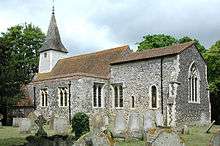All Saints Church, West Stourmouth
| All Saints Church, West Stourmouth | |
|---|---|
 All Saints Church, West Stourmouth, from the southeast | |
 All Saints Church, West Stourmouth Location in Kent | |
| Coordinates: 51°19′13″N 1°14′11″E / 51.3203°N 1.2365°E | |
| OS grid reference | TR 256 628 |
| Location | Stourmouth, Kent |
| Country | England |
| Denomination | Anglican |
| Website | Churches Conservation Trust |
| Architecture | |
| Functional status | Redundant |
| Heritage designation | Grade I |
| Designated | 11 October 1963 |
| Architectural type | Church |
| Specifications | |
| Materials |
Flint with stone dressings, Tiled roofs |
All Saints Church, West Stourmouth, is a redundant Anglican church in the civil parish of Stourmouth, Kent, England. It is recorded in the National Heritage List for England as a designated Grade I listed building,[1] and is under the care of the Churches Conservation Trust.[2] The church stands in the settlement of West Stourmouth, some 4 miles (6 km) north of Wingham to the southeast of the A28 road.[2][3]
History
The main fabric in the church is Saxon. Alterations were made in the late 12th century.[1] The church was damaged in an earthquake in 1382, and was subsequently rebuilt.[4] Windows were replaced in the 14th and 15th centuries. The church was restored in 1845, when the seating was reorganised. It has been redundant since 1979.[1]
Architecture
Exterior
The church is constructed in flint with stone dressings and tiled roofs. Its plan consists of a nave with north and south aisles, a chancel, a south porch, and a west tower. The tower is weatherboarded with a shingled spire, and is supported by two 17th-century massive brick buttresses. Between the buttresses is a porch, above which is a 15th-century two-light window. The south aisle has a brick parapet and contains three two-light ogee-headed 14th-century windows. The south porch is gabled with corner buttresses. The east wall of the chancel was rebuilt in the 19th century, and contains a Decorated style window. In the south wall are two lancet windows, and there is a similar window on the north side. Only the lower half of the north aisle survives, and it contains two hipped dormers.[1]
Interior
The chancel has dado panelling, a piscina and choir stalls, all dating from the 17th century. The base of a rood screen with four panels is still present. Also dating from the 17th century are an octagonal pulpit and box pews. In the chancel is a brass dated 1472. There are fragments of 15th-century glass in the south window of the chancel.[1] Also in the church are the royal arms of George III.[2]
Parish Status
The church is part of a joint benefice which includes:
- St Nicholas' Church, Ash
- All Saints' Church, Chillenden
- Elmstone Church
- Holy Cross Church, Goodnestone
- St Mildred' Church, Preston
- St Mary's Church, Wingham
See also
References
- 1 2 3 4 5 Historic England, "Church of All Saints, Stourmouth (1203363)", National Heritage List for England, retrieved 2 July 2013
- 1 2 3 All Saints' Church, West Stourmouth, Kent, Churches Conservation Trust, retrieved 13 May 2011
- ↑ West Stourmouth, Streetmap, retrieved 17 March 2011
- ↑ West Stourmouth, All Saints Church, Britain Express, retrieved 17 March 2011